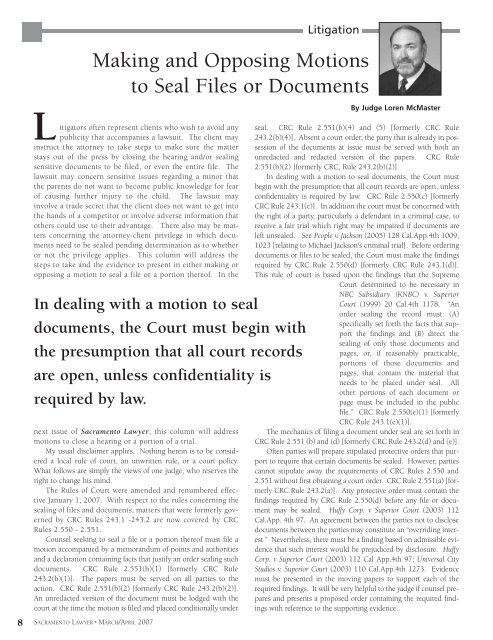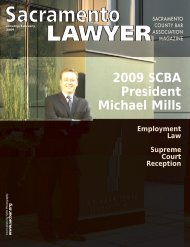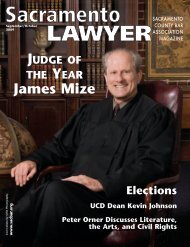March / April 2007 - Sacramento County Bar Association
March / April 2007 - Sacramento County Bar Association
March / April 2007 - Sacramento County Bar Association
Create successful ePaper yourself
Turn your PDF publications into a flip-book with our unique Google optimized e-Paper software.
8<br />
Litigators often represent clients who wish to avoid any<br />
publicity that accompanies a lawsuit. The client may<br />
instruct the attorney to take steps to make sure the matter<br />
stays out of the press by closing the hearing and/or sealing<br />
sensitive documents to be filed, or even the entire file. The<br />
lawsuit may concern sensitive issues regarding a minor that<br />
the parents do not want to become public knowledge for fear<br />
of causing further injury to the child. The lawsuit may<br />
involve a trade secret that the client does not want to get into<br />
the hands of a competitor or involve adverse information that<br />
others could use to their advantage. There also may be matters<br />
concerning the attorney-client privilege in which documents<br />
need to be sealed pending determination as to whether<br />
or not the privilege applies. This column will address the<br />
steps to take and the evidence to present in either making or<br />
opposing a motion to seal a file or a portion thereof. In the<br />
next issue of <strong>Sacramento</strong> Lawyer, this column will address<br />
motions to close a hearing or a portion of a trial.<br />
My usual disclaimer applies. Nothing herein is to be considered<br />
a local rule of court, an unwritten rule, or a court policy.<br />
What follows are simply the views of one judge, who reserves the<br />
right to change his mind.<br />
The Rules of Court were amended and renumbered effective<br />
January 1, <strong>2007</strong>. With respect to the rules concerning the<br />
sealing of files and documents, matters that were formerly governed<br />
by CRC Rules 243.1 -243.2 are now covered by CRC<br />
Rules 2.550 - 2.551.<br />
Counsel seeking to seal a file or a portion thereof must file a<br />
motion accompanied by a memorandum of points and authorities<br />
and a declaration containing facts that justify an order sealing such<br />
documents. CRC Rule 2.551(b)(1) [formerly CRC Rule<br />
243.2(b)(1)]. The papers must be served on all parties to the<br />
action. CRC Rule 2.551(b)(2) [formerly CRC Rule 243.2(b)(2)].<br />
An unredacted version of the document must be lodged with the<br />
court at the time the motion is filed and placed conditionally under<br />
SACRAMENTO LAWYER ■ MARCH/APRIL <strong>2007</strong><br />
Litigation<br />
Making and Opposing Motions<br />
to Seal Files or Documents<br />
In dealing with a motion to seal<br />
documents, the Court must begin with<br />
the presumption that all court records<br />
are open, unless confidentiality is<br />
required by law.<br />
By Judge Loren McMaster<br />
seal. CRC Rule 2.551(b)(4) and (5) [formerly CRC Rule<br />
243.2(b)(4)]. Absent a court order, the party that is already in possession<br />
of the documents at issue must be served with both an<br />
unredacted and redacted version of the papers. CRC Rule<br />
2.551(b)(2) [formerly CRC, Rule 243.2(b)(2)].<br />
In dealing with a motion to seal documents, the Court must<br />
begin with the presumption that all court records are open, unless<br />
confidentiality is required by law. CRC Rule 2.550(c) [formerly<br />
CRC Rule 243.1(c)]. In addition the court must be concerned with<br />
the right of a party, particularly a defendant in a criminal case, to<br />
receive a fair trial which right may be impaired if documents are<br />
left unsealed. See People v. Jackson (2005) 128 Cal.App.4th 1009,<br />
1023 [relating to Michael Jackson's criminal trial]. Before ordering<br />
documents or files to be sealed, the Court must make the findings<br />
required by CRC Rule 2.550(d) [formerly CRC Rule 243.1(d)].<br />
This rule of court is based upon the findings that the Supreme<br />
Court determined to be necessary in<br />
NBC Subsidiary (KNBC) v. Superior<br />
Court (1999) 20 Cal.4th 1178. “An<br />
order sealing the record must: (A)<br />
specifically set forth the facts that support<br />
the findings and (B) direct the<br />
sealing of only those documents and<br />
pages, or, if reasonably practicable,<br />
portions of those documents and<br />
pages, that contain the material that<br />
needs to be placed under seal. All<br />
other portions of each document or<br />
page must be included in the public<br />
file.” CRC Rule 2.550(e)(1) [formerly<br />
CRC Rule 243.1(e)(1)].<br />
The mechanics of filing a document under seal are set forth in<br />
CRC Rule 2.551 (b) and (d) [formerly CRC Rule 243.2(d) and (e)].<br />
Often parties will prepare stipulated protective orders that purport<br />
to require that certain documents be sealed. However, parties<br />
cannot stipulate away the requirements of CRC Rules 2.550 and<br />
2.551 without first obtaining a court order. CRC Rule 2.551(a) [formerly<br />
CRC Rule 243.2(a)]. Any protective order must contain the<br />
findings required by CRC Rule 2.550(d) before any file or document<br />
may be sealed. Huffy Corp. v Superior Court (2003) 112<br />
Cal.App. 4th 97. An agreement between the parties not to disclose<br />
documents between the parties may constitute an “overriding interest.”<br />
Nevertheless, there must be a finding based on admissible evidence<br />
that such interest would be prejudiced by disclosure. Huffy<br />
Corp. v Superior Court (2003) 112 Cal App.4th 97; Universal City<br />
Studios v. Superior Court (2003) 110 Cal.App.4th 1273. Evidence<br />
must be presented in the moving papers to support each of the<br />
required findings. It will be very helpful to the judge if counsel prepares<br />
and presents a proposed order containing the required findings<br />
with reference to the supporting evidence.






